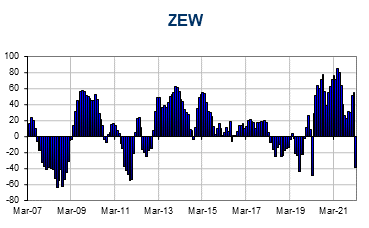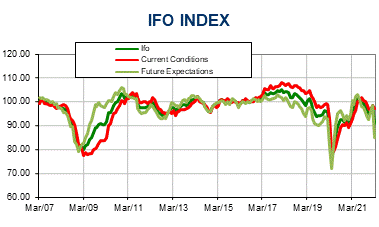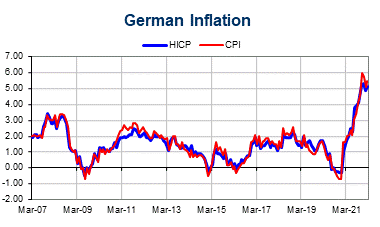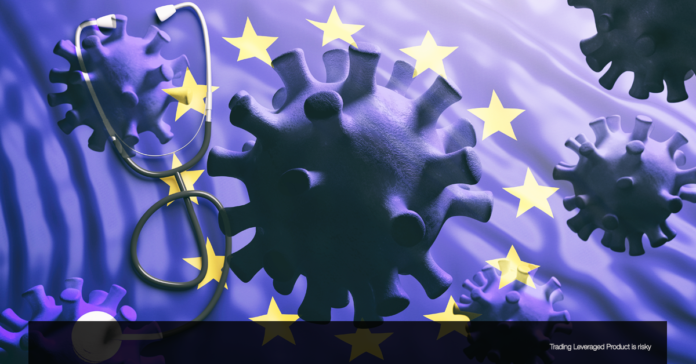German state inflation data today have been mixed, with some states reporting an acceleration in the headline rate, others a slight decline. On the whole there may be a slight downside risk to preliminary pan Germany numbers, due this afternoon. Expectations are for a steady HICP rate of 1.6% and even if the headline comes in a tad lower, PMI readings this morning highlighted once again that cost pressures are building in the manufacturing sector, which together with higher energy prices could push up consumer prices once consumption demand rebounds.
Germany has had a stricter lockdown than France, Italy or Spain, but individual states have started to re-open activity today, even though overall numbers are not where the government would like them to be. However, German inflation numbers are likely to remain above the Eurozone average for a while and the ECB clearly is not expecting headline rates to top targets any time soon. Even if they eventually do, the shift towards a more symmetric target would require letting inflation run hot for a while following the current period of underinflation.
Overall, Germany’s economy not only weathered the first wave of the pandemic better than other major EU countries, it also expanded in the last quarter of 2020, despite the return of a relatively strict lockdown. Activity is still likely to contract in Q1, but Germany is set to escape a technical recession. At the same time, underlying price pressures are starting to pick up. With the ECB focused on the Eurozone average, Germany is likely to post above average inflation and risks fresh bubbles in house prices down the line.
German GDP growth was unexpectedly revised up to 0.3% q/q in the final reading for Q4 2020 – from 0.1% q/q reported initially. This left the annual rate at -3.7% y/y (working day adjusted). Still a sizeable contraction, but a much better result than developments in the EU as a whole. Not surprisingly consumption was severely hit by virus developments and the return of stay-home-orders at the end of last year. The rebound in machinery investment also came to a halt, even as construction investment continued to expand. Exports, however, lifted a further 4.5% q/q, while imports jumped 3.7%, and together with a marked rise in stock building that suggests companies prepared for Brexit with pre-emptive orders and a build up of stock levels.

Manufacturing PMIs are at the highest level in 37 months across Germany, France and Italy, highlighting that despite ongoing virus restrictions, the manufacturing sector is looking very strong. Markit reported that “producers are benefitting from resurgent demand for goods in both domestic and export markets, linked to post-Covid recovery hopes” and “renewed stock building and investment in business equipment and machinery”, is adding to improved consumption. Good news for overall economic activity ahead, but also highlighting that inflation pressures are building, and that reflation trades are not totally unfounded.
This is also reflected in other survey data for February. The overall Ifo reading lifted to 92.4, the highest since October last year, driven not just by an improvement in the expectations index, but also a strengthening in the current conditions indicator. Not surprisingly, manufacturing sentiment turned even more positive, but even the services sector and retail trade are less pessimistic, despite ongoing restrictions. Vaccination programs and the sharp decline in active cases in Germany have boosted hopes for a re-opening of the economy and indeed, many German states have started to open schools this week starting with Kindergartens and primary schools. Others are set to follow in coming weeks.

The improvements suggested by the Ifo and PMI readings confirm that the jump in the ZEW earlier in the month was not just a reflection of buoyant investor confidence, but actually reflects improvement at company level. At the same time, the PMI in particular flagged supply chain shortages and a marked rise in costs and subsequently prices charged. German headline inflation already jumped markedly at the start of the year, as the temporary cut to the VAT rate fell out of the equation and developments at factory level suggest a further build up of underlying price pressures.
Markit reported that average charges for goods and services rose at the fastest rate since August 2019 – mainly driven by manufacturing output price, which rose at the fastest pace in nearly two-and-a-half years. Input costs have seen the sharpest increases in nearly a decade, reflecting not just higher raw material prices, but also upward pressure on transportation costs. Input price inflation across both manufacturing and services reached a 27-month high in February and the numbers suggest a further increase in price pressures down the line. The fact that companies are able to pass on costs highlights that there is no shortage of demand, despite rising prices, and as long as consumption bounces back once lockdowns are lifted, that could quickly lead to a sharp rise in consumer price inflation down the line.

What is pretty evident is the fact that the manufacturing sector clearly is pretty unfazed by latest lockdowns and that Germany’s export oriented economy is benefiting the storm better than others. Indeed, countries such as Spain, which rely heavily on services and tourism, will see a much larger boom bust cycle, but also a bigger share of income that is permanently lost. For Germany that means that the ECB’s one-size-fits-all monetary policy will be too expansionary for the domestic economy for a while to come. Traditional savings will remain unattractive and stock market and property investment look attractive by comparison. For national regulators that also means they need to keep a close eye on potential bubbles and insufficient risk management as money remains cheap.
Click here to access the our Economic Calendar
Andria Pichidi
Market Analyst
Disclaimer: This material is provided as a general marketing communication for information purposes only and does not constitute an independent investment research. Nothing in this communication contains, or should be considered as containing, an investment advice or an investment recommendation or a solicitation for the purpose of buying or selling of any financial instrument. All information provided is gathered from reputable sources and any information containing an indication of past performance is not a guarantee or reliable indicator of future performance. Users acknowledge that any investment in Leveraged Products is characterized by a certain degree of uncertainty and that any investment of this nature involves a high level of risk for which the users are solely responsible and liable. We assume no liability for any loss arising from any investment made based on the information provided in this communication. This communication must not be reproduced or further distributed without our prior written permission.



















